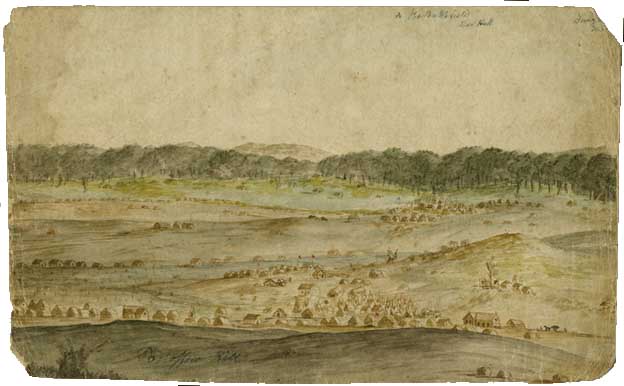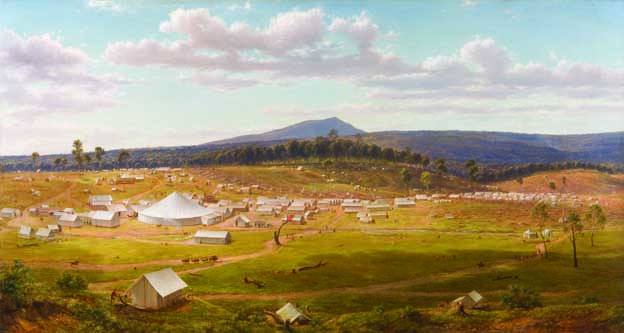Difference between revisions of "William Symonds"
Dottigee16 (talk | contribs) (→Post 1854 Experiences) |
Dottigee16 (talk | contribs) (→Post 1854 Experiences) |
||
| (15 intermediate revisions by the same user not shown) | |||
| Line 1: | Line 1: | ||
| + | [[File:1996.62 - Doudiet - The Battlefield - Red Hill wiki.jpg|1000px|thumb|right|Charles A. Doudiet, ''The Battlefield - Red Hill (From Post Office Hill)'', 1854, watercolour, pen and ink on paper.<br>Courtesy Art Gallery of Ballarat, purchased by the Ballarat Fine Art Gallery with assistance of many donors, 1996.]] | ||
| + | [[File:VonGuerard-old ballarat cleaned-wiki.jpg|1000px|thumb|right|Eugene von Guerard, ''Old Ballarat as it was in the summer of 1853-54'', 1884, oil on canvas, mounted on board, Art Gallery of Ballarat Collection, Gift of James Oddie on Eureka Day, 1885.]] | ||
==Background== | ==Background== | ||
| − | + | William Gumma Symonds was born around October 1831 at Nankervis Farm, [[St Enoder]] [[Cornwall]]. He came to South Australia with his parents and family. He and his brother [[Francis Symonds]] left for the Victorian goldfields. William Symonds married Jane Healy in 1853. Note* According to the Victorian Marriage Registrations William Symonds married Jane Harvey in 1856, although in family history records Jane's name is recorded as Healy.<ref>Corfield, J.,Wickham, D., & Gervasoni, C. ''The Eureka Encyclopaedia'', Ballarat Heritage Services, 2004.</ref> | |
| − | William Gumma Symonds was born | ||
==Goldfields Involvement, 1854== | ==Goldfields Involvement, 1854== | ||
| − | + | By 1854 William Gumma Symonds with his brother [[Francis Symonds]] following the gold rushes.<ref>Corfield, J.,Wickham, D., & Gervasoni, C. ''The Eureka Encyclopaedia'', Ballarat Heritage Services, 2004.</ref> | |
| − | William Symonds | ||
| − | |||
| − | |||
A notice placed in the ''Observer'' in Messages to the Diggings by Francis Symonds reads: | A notice placed in the ''Observer'' in Messages to the Diggings by Francis Symonds reads: | ||
| Line 28: | Line 26: | ||
==Post 1854 Experiences== | ==Post 1854 Experiences== | ||
| + | William Symonds married Jane Healy and they moved to Scrub Hill in 1858, where they farmed.<ref>Corfield, J.,Wickham, D., & Gervasoni, C. ''The Eureka Encyclopaedia'', Ballarat Heritage Services, 2004.</ref> | ||
| − | William and Jane Symonds left for Queensland.<ref>Corfield, J.,Wickham, D., & Gervasoni, C. ''The Eureka Encyclopaedia'', Ballarat Heritage Services, 2004.</ref>W. G. Symonds reported that he had found gold around 50km north-west of Rockhampton in 1861, Queensland so he had moved from Adelaide to Victoria and then to Queensland by 1861. The birth of William Healy Symonds was registered at the Charters Towers Court House in 1871, the mother listed as Jane Healy. | + | William and Jane Symonds left for Queensland.<ref>Corfield, J.,Wickham, D., & Gervasoni, C. ''The Eureka Encyclopaedia'', Ballarat Heritage Services, 2004.</ref> |
| + | W. G. Symonds reported that he had found gold around 50km north-west of Rockhampton in 1861, Queensland, so he had moved from Adelaide to Victoria and then to Queensland by 1861. The birth of William Healy Symonds was registered at the Charters Towers Court House in 1871, the mother listed as Jane Healy. | ||
William Gumma Symonds was listed by 1874 as the postmaster and lessee of the ''Carrier Arms Hotel''. He is listed in various directories as a squatter on Ravenswood, Tallegulla and Nulla Nulla Stations, all around the Charters Towers area.<ref>John L. Symonds, Which Francis Symonds? Cornish Oak or Australian Eucalypt?, 1993, pp.115-116.</ref> | William Gumma Symonds was listed by 1874 as the postmaster and lessee of the ''Carrier Arms Hotel''. He is listed in various directories as a squatter on Ravenswood, Tallegulla and Nulla Nulla Stations, all around the Charters Towers area.<ref>John L. Symonds, Which Francis Symonds? Cornish Oak or Australian Eucalypt?, 1993, pp.115-116.</ref> | ||
| Line 35: | Line 35: | ||
William married Catherine Farrell on 5 December 1878 at Dalrymple, Queensland. He married again to Mary Scanlon on 18 July 1881 at Charters Towers, Queensland and this couple lived at Nulla Nulla Station. According to family history, William and Mary 'lived in a house which is said to have been constructed without nails and using greenhide bonds - by a man who was originally a sailor. Five boys and one girl were born at Nulla Nulla and a boy was born in Townsville. In the 1880s they visited the family at Rosedalw, Chain of Ponds near Adelaide, but unfortunately, their young baby Francis, just a few months old, died on 19 February 1884 and was buried in the Symonds family plot at Philp Town Cemetery.<ref>Burial entry no. 40 Francis Symonds, buried 20 February 1884, aged 7 months.</ref> | William married Catherine Farrell on 5 December 1878 at Dalrymple, Queensland. He married again to Mary Scanlon on 18 July 1881 at Charters Towers, Queensland and this couple lived at Nulla Nulla Station. According to family history, William and Mary 'lived in a house which is said to have been constructed without nails and using greenhide bonds - by a man who was originally a sailor. Five boys and one girl were born at Nulla Nulla and a boy was born in Townsville. In the 1880s they visited the family at Rosedalw, Chain of Ponds near Adelaide, but unfortunately, their young baby Francis, just a few months old, died on 19 February 1884 and was buried in the Symonds family plot at Philp Town Cemetery.<ref>Burial entry no. 40 Francis Symonds, buried 20 February 1884, aged 7 months.</ref> | ||
| − | William Gumma Symonds died at Townsville, Queensland on 25 December 1900.<ref>John L. Symonds, Which Francis Symonds? Cornish Oak or Australian Eucalypt?, 1993, pp. 115-116.</ref> | + | William Gumma Symonds died at Townsville Hospital, Queensland on 25 December 1900. He was buried at West End Cemetery, Townsville. <ref>John L. Symonds, Which Francis Symonds? Cornish Oak or Australian Eucalypt?, 1993, pp. 115-116.</ref> |
==See also== | ==See also== | ||
| Line 50: | Line 50: | ||
==External links== | ==External links== | ||
| + | The homestead of Nulla Nulla in Queensland about 1160km northwest of Brisbane. Nulla Nulla is at an altitude of about 592m above sea level. | ||
| + | The nearest more populous place is the town of Charters Towers which is 120km away with a population of around 8,500 | ||
| + | https://austcemindex.com/cemetery?cemid=6137 | ||
---- | ---- | ||
[[File:File name.jpg|500px|thumb|left|''Caption,'' Reference.]] | [[File:File name.jpg|500px|thumb|left|''Caption,'' Reference.]] | ||
Latest revision as of 11:08, 20 June 2023
Contents
Background
William Gumma Symonds was born around October 1831 at Nankervis Farm, St Enoder Cornwall. He came to South Australia with his parents and family. He and his brother Francis Symonds left for the Victorian goldfields. William Symonds married Jane Healy in 1853. Note* According to the Victorian Marriage Registrations William Symonds married Jane Harvey in 1856, although in family history records Jane's name is recorded as Healy.[1]
Goldfields Involvement, 1854
By 1854 William Gumma Symonds with his brother Francis Symonds following the gold rushes.[2]
A notice placed in the Observer in Messages to the Diggings by Francis Symonds reads:
- Francis Symonds, Chain of ponds near Adelaide
- wishes to hear from his sons, Francis and William G Symonds
- as he has not heard of them for some time
- Should any person know or hear of them a
- letter would be thankfully received.[3]
Under the Spelling of Symmons[4], Francis Symonds was listed as wounded and since recovered from the Eureka Stockade battle [5]
John L. Symonds writes: Francis and William Gumma Symonds must have been in Ballarat prior to the period when the diggers began objecting vociferously to the way the police enforced and harassed them over their possession or otherwise of mining licences. Francis became involved in the Eureka Stockade affair at Ballarat and was wounded during the ensuing fracas. In the report by Peter Lalor on those killed and wounded on the morning of December 3, 1854, one person involved was listed as Frank Symmons, England under the heading Wounded and since Recovered. One gathers that Frank Symmons must have been in the thick of it and recognised as a colleague and participant by Lalor.[6]
Post 1854 Experiences
William Symonds married Jane Healy and they moved to Scrub Hill in 1858, where they farmed.[7]
William and Jane Symonds left for Queensland.[8] W. G. Symonds reported that he had found gold around 50km north-west of Rockhampton in 1861, Queensland, so he had moved from Adelaide to Victoria and then to Queensland by 1861. The birth of William Healy Symonds was registered at the Charters Towers Court House in 1871, the mother listed as Jane Healy.
William Gumma Symonds was listed by 1874 as the postmaster and lessee of the Carrier Arms Hotel. He is listed in various directories as a squatter on Ravenswood, Tallegulla and Nulla Nulla Stations, all around the Charters Towers area.[9]
William married Catherine Farrell on 5 December 1878 at Dalrymple, Queensland. He married again to Mary Scanlon on 18 July 1881 at Charters Towers, Queensland and this couple lived at Nulla Nulla Station. According to family history, William and Mary 'lived in a house which is said to have been constructed without nails and using greenhide bonds - by a man who was originally a sailor. Five boys and one girl were born at Nulla Nulla and a boy was born in Townsville. In the 1880s they visited the family at Rosedalw, Chain of Ponds near Adelaide, but unfortunately, their young baby Francis, just a few months old, died on 19 February 1884 and was buried in the Symonds family plot at Philp Town Cemetery.[10]
William Gumma Symonds died at Townsville Hospital, Queensland on 25 December 1900. He was buried at West End Cemetery, Townsville. [11]
See also
Francis Symonds, brother
Further Reading
Corfield, J.,Wickham, D., & Gervasoni, C. The Eureka Encyclopaedia, Ballarat Heritage Services, 2004.
References
- ↑ Corfield, J.,Wickham, D., & Gervasoni, C. The Eureka Encyclopaedia, Ballarat Heritage Services, 2004.
- ↑ Corfield, J.,Wickham, D., & Gervasoni, C. The Eureka Encyclopaedia, Ballarat Heritage Services, 2004.
- ↑ Torrens Valley Historical Journal, No. 39, December 1991, p. 14.
- ↑ Carboni, Raffaello, The Eureka Stockade, 1855, pg 137.
- ↑ Dorothy Wickham, Deaths at Eureka, 1996
- ↑ John L. Symonds, Which Francis Symonds? Cornish Oak or Australian Eucalypt?: A History of the Symonds Families in Cornwall and Australia 1675 to 1992, Published 1993, pp. 114-115.
- ↑ Corfield, J.,Wickham, D., & Gervasoni, C. The Eureka Encyclopaedia, Ballarat Heritage Services, 2004.
- ↑ Corfield, J.,Wickham, D., & Gervasoni, C. The Eureka Encyclopaedia, Ballarat Heritage Services, 2004.
- ↑ John L. Symonds, Which Francis Symonds? Cornish Oak or Australian Eucalypt?, 1993, pp.115-116.
- ↑ Burial entry no. 40 Francis Symonds, buried 20 February 1884, aged 7 months.
- ↑ John L. Symonds, Which Francis Symonds? Cornish Oak or Australian Eucalypt?, 1993, pp. 115-116.
External links
The homestead of Nulla Nulla in Queensland about 1160km northwest of Brisbane. Nulla Nulla is at an altitude of about 592m above sea level. The nearest more populous place is the town of Charters Towers which is 120km away with a population of around 8,500
https://austcemindex.com/cemetery?cemid=6137

